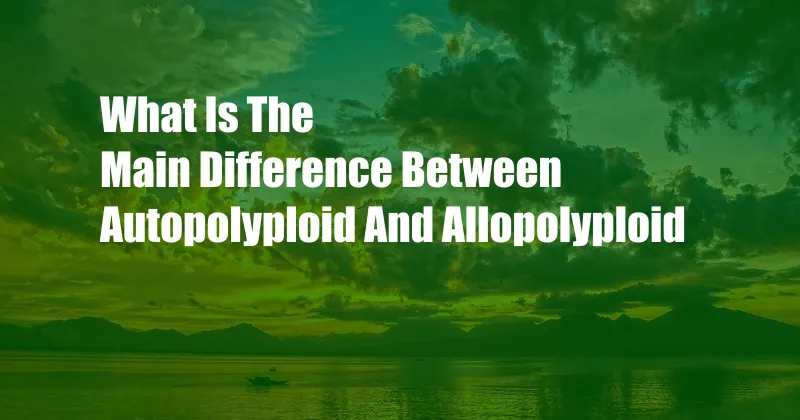
What is the Main Difference Between Autopolyploid and Allopolyploid?
In the world of plants, polyploidy, a condition where an organism has more than two complete sets of chromosomes, plays a significant role in evolution, speciation, and the formation of new and distinct species. Among the different types of polyploidy, autopolyploidy and allopolyploidy stand out as the two primary forms. Understanding the fundamental difference between these two types of polyploidy can provide valuable insights into the complexities of plant genetics.
Autopolyploidy: A Duplication of Self
Autopolyploidy occurs when an organism contains multiple complete sets of identical chromosomes. This can result from various mechanisms, such as the fusion of unreduced gametes (eggs or sperm) or through mitotic errors during cell division. In an autopolyploid, the additional chromosome sets are derived from the same parental genome, meaning the organism is essentially a multiple of itself.
Allopolyploidy: A Merger of Genomes
In contrast to autopolyploidy, allopolyploidy arises from the hybridization of two different species, resulting in a new organism with combined genetic material from both parents. This merging of distinct genomes can lead to novel combinations of traits, potentially providing selective advantages and driving the formation of new species. The chromosomal complement of an allopolyploid comprises one or more complete sets of chromosomes from each parental species.
Implications and Significance
Both autopolyploidy and allopolyploidy have profound implications for plant evolution and ecology. Autopolyploidy can immediately double the chromosome number, resulting in larger cell size, increased vigor, and altered gene expression patterns. This can lead to the development of new morphological and physiological traits, including enhanced resistance to environmental stresses and increased reproductive capacity.
Allopolyploidy, on the other hand, can result in a wider range of genetic variation and novel combinations of traits. The fusion of distinct genomes can create new genetic interactions and regulatory networks, leading to a broader spectrum of phenotypic possibilities. Allopolyploidy is recognized as a major force in plant evolution, contributing to the emergence of new species and the diversification of plant lineages.
Examples of Polyploidy in Nature
Autopolyploidy is commonly found in many plant species, such as potatoes (tetraploid with four sets of chromosomes) and strawberries (octoploid with eight sets of chromosomes). Allopolyploidy, too, is widespread in plants, with notable examples including wheat (hexaploid with three sets of chromosomes from two different species) and cotton (allotetraploid with four sets of chromosomes from two different species).
Conclusion
Autopolyploidy and allopolyploidy represent two distinct forms of polyploidy with significant implications for plant evolution and genetics. Understanding the differences between these two types of polyploidy paves the way for further research into the mechanisms, consequences, and applications of polyploidy in the plant kingdom. As researchers continue to explore the world of polyploidy, we can anticipate new insights into the intricate processes shaping plant diversity and adaptation.